 |
 |
 |
| |
Improved Cardiac Disease Management, Risk for Myocardial Infarction Stabilizes
|
| |
| |
Reported by Jules Levin
CROI, Feb 2007, Los Angeles
".....This stabilization of MI rates is possibly due to improved risk management including the use of lipid lowering therapy and shifting to more lipid friendly regimens..." but CHD/MI rates are higher among HIV+ compared to HIV-negatives....
Surveillance Data for MI Hospitalizations among HIV+ and HIV- Northern Californians: 1994-2006
D. Klein*1, L. Hurley2, M. Silverberg2, M Horberg2, C. Quesenberry2, and S. Sidney2
Kaiser Permanente, Hayward, California, USA1 and Kaiser Permanente, Oakland, California, USA2
CONCLUSIONS
CHD / MI rates among CHD / MI rates among HIV+ patients compared to HIV- patients are significantly higher.
Rates of CHD are significantly higher in PI-exposed vs. PI-unexposed patients and the higher rate of MI events approaches statistical significance.
Risk of MI appears to rise with increasing duration of PI exposure.
The unfavorable effect of HIV and its treatment on MI risk was greatest early in the HAART era, but has not continued to rise.
This stabilization of MI rates is possibly due to improved risk management
including the use of lipid lowering therapy (Silverberg, CROI-14, Abs. #814)
and shifting to more lipid friendly regimens, for example reduced use of
D4T and increased use of TDF and ATV.
The effect of HIV on MI appears greater in women than in men.
Continued CHD risk management and surveillance of such events in HIV+
patients as compared to our HIV- patient population are warranted.
RESULTS
Original cohort:
10.5 yrs of observation (30,433 person yrs), 162 CHD events (101 MIs). Table 1.
Age-adjusted CHD/MI rates for HIV+'s were higher than for HIV-'s (CHD: 6.1 vs.
2.9 events/1000 PY, p<.0001; MI: 3.7 vs. 2.2, p=.001). Table 2.
Age-adjusted relative rates for pre- vs. post-PI exposure continue to suggest
increased risk with PI exposure (CHD: 4.5 vs. 7.1, p=.02; MI: 2.9 vs. 4.4, p=.09).Table 2.
Risk appears to increase with duration of exposure to PIs: overall age-adjusted
relative risk for MI was: 1.16 per year of PI exposure (p=.10). Figure 1.
Surveillance cohort:
Before HAART era relative risk of MI among HIV+ (vs. HIV-) was 0.85 (p=.65),
but in 1996-1999 rose to 1.96 (p<.0001) and in 2000-2006 was 1.78 (p<.0001).
Table 3.
MI rate among HIV- patients did not change over 1994-2006. Table 3.
For 1996-2006 the relative rate for HIV+ women vs. HIV- women was 3.99
(p<.001) and for HIV+ men vs. HIV- men was 1.78 (p<.0001). Table 3.
Percent of ART-treated patients on D4T continues to decline while the percent
on TDF and ATV (heart-friendly agents) continues to rise. Figure 3.
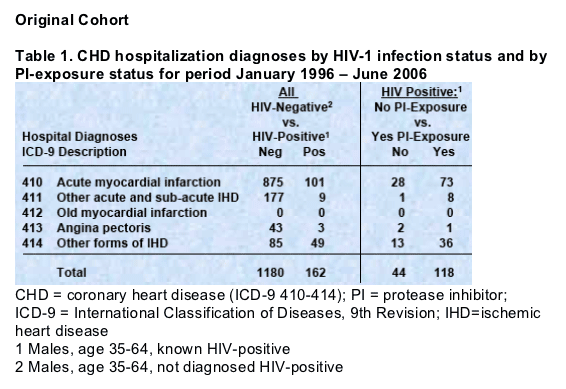
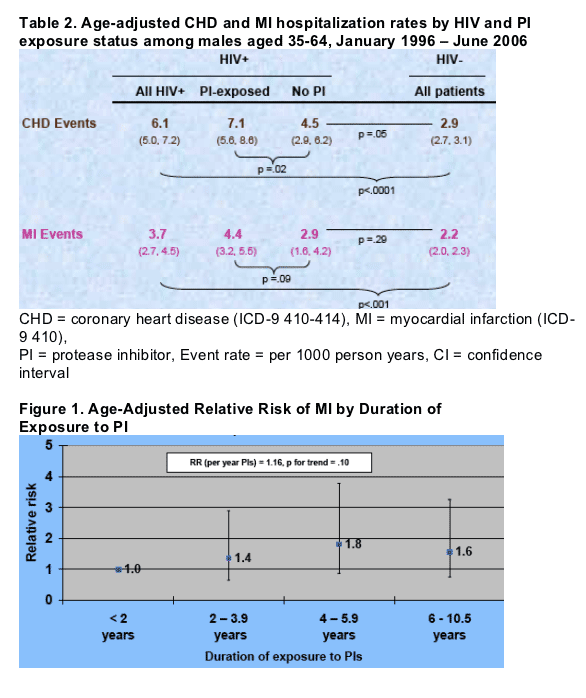
Surveillance Cohort
Figure 2. Age adjusted rates* of MI hospitalizations among HIV-infected
and HIV-uninfected KPNC members.
Crude rates (rates are lower after adjustments) for HIV+ of MI hospitalizations were 5.6 & 5.2 (events per 1000 person years) in 1996-1997 and 1998-1999, respectively. Rate for HIV+ was 2.2 in 1994-1995. Rates appear to at least stabilize & perhaps decline in following years: 3.9 in 2000-2001, 3.9 for 2002-2003, and 4.4 for 2004-2006. At the same time rates for HIV-negatives remained about the same through all these time periods: 2.5 in 1994-1995, 2.7 in ’96-’97, 2.8 in ’98-’99, 2.4 in ’00-’01, 2.6 in ’02-’03, and 2.3 in ’04-’06.
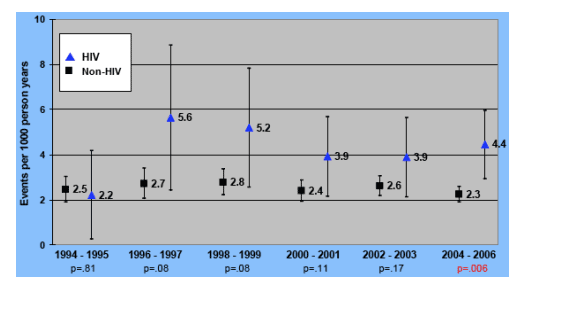
Table 3. Surveillance for MIs among HIV+ and HIV- KPNC members aged 35-64: 1994-2006.
*Poisson regression adjusting for age, gender, HIV status, calendar era and HIV/calendar era interaction
** HAART era only, all years 1996-2006 combined
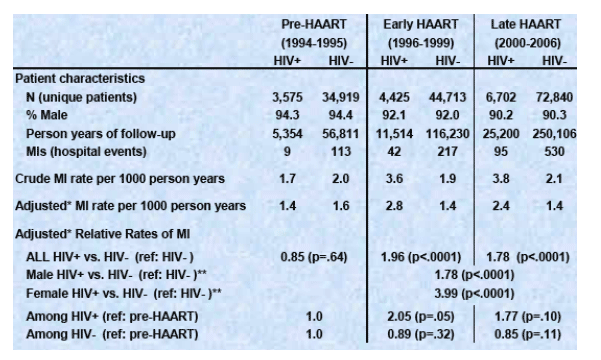
Figure 3. Changes in antiretroviral (ARV) prescribing
patterns that may lead to improved lipid profiles
The data in firgure 3 shows d4T use declined from 49% in patients in 2000 to 8.5% in 2006; tenofovir use increased from 3% in 2001 to 54.8% in 2006; Reyataz use increased from 6.4% to 37.2% from 2003 to 2006.
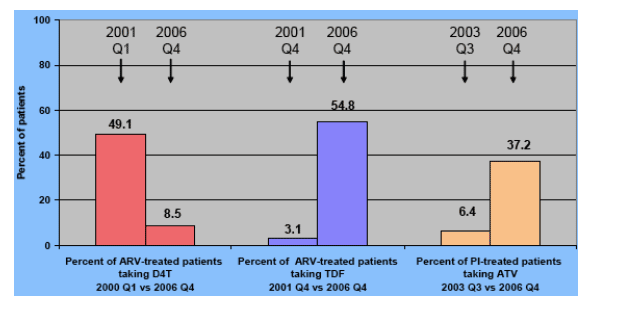
BACKGROUND
Coronary heart disease (CHD) and the contributory role of antiretroviral therapy continues to be a concern in the long term care of HIV+ patients.
Clinicians within Kaiser Permanente Northern California are prescribing ‘heart-healthier’ regimens whenever possible and are managing traditional CHD risks more aggressively (CROI-13 Abs. #737).
Ongoing surveillance of CHD events and reporting on changes in practice patterns and risk profiles are needed.
METHODS
Kaiser Permanente of Northern California (KPNC) has 3 million members
and has cared for 17,000 HIV+ members of whom approximately 5400 are
current health plan members.
We update estimates of CHD and myocardial infarction (MI) event rates
among our original cohort of ~5,000 CHD-free HIV+ males followed from
1996 through 6/30/2006 and compare them to rates among ~43,000 agematched
HIV- males (original work in Klein, JAIDS, 08/15/2002).
We update our comparison of CHD/MI rates among protease inhibitor (PI) - exposed and PI-unexposed HIV+ patients in the original cohort.
Among a population-based surveillance cohort of all KPNC HIV+ patients aged 35-64 and age/sex matched HIV- KPNC members, we provide age/sex
adjusted MI rates, as well as relative rates (RR, ref. HIV-) over three periods: pre-HAART (1994-1995), early HAART (1996-2000) and late HAART (2001-2006).
We also provide RR of MI for calendar period separately among HIV+ and HIV- persons (ref. pre-HAART), and RR for HIV separately among men and women in the HAART era (ref. HIV-).
We report changes in the use of selected antiretoviral therapies (ART): stavudine (D4T), tenofovir (TDF) and atazanavir (ATV) in all patients.
|
| |
|
 |
 |
|
|